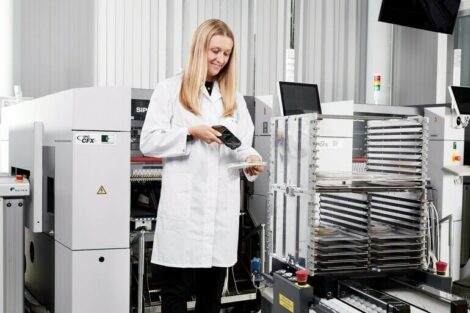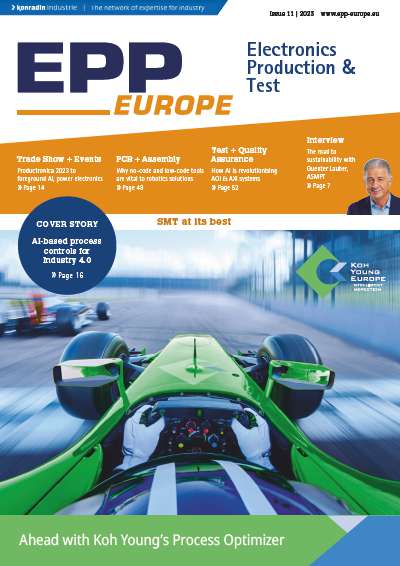There are many different models of manual wire bonders on the market, ranging from very simple, frugal models for the occasional trial bond up to quasi-automatic machines which can be used for small-scale production and replace a fully automatic bonder. What is striking, however, is that in this plethora of bonders to choose from there is practically no model for heavy-wire bonding. This is even more surprising given that heavy-wire bonding is poised to make a big step out from its customary niche presence, thanks to sharply increased interest in this technology from many different applications in electro-automotive and solar areas, and in the power-control industry in general.
Dr. Josef Sedlmair, F&K Delvotec Semiconductor, Braunau/Inn (A)
All the more reason for F&K Delvotec Semiconductor in Braunau, Austria, to expand its highly successful product line to include a heavy-wire bonder model. It is strategically placed to round out the bonder range at the entry level and offer a fully functional machine for the budget-conscious user who does not have the budget for the more highly automated 56XX family with its exchangeable bond- and test-heads.
Dual-motion system
The new model 5350 is embedded in the highly successful model family 5300 and matches the sister models for thin-wire wedge-wedge 5330, ball-wedge 5310 and combination deep-access/ball-wedge 53XXBDA in basic mechanics, electronics, software and design. In this vein, the 5350 heavy wire bonder contains a motorized, fully programmable and linear Z axis with a large stroke of 60 mm, allowing access even into deep packages and complicated circuits to make best use of the standard 2-inch bonding tools. What is unexpected in this machine is the second motorized and programmable axis which moves in the Y axis. It also contains a spindle which, powered by a stepping motor, allows bonds of up to 25 mm length being formed automatically or manually, just as the operator desires. The big advantage of this dual-motion system is that the most critical part of a heavy-wire bond, the cutting motion, is performed completely automatically, because the step-back, cutting and tear-off are under full program control with individually settable parameters. This is critical for the bond quality because heavy wire bonds have to be cut at the second bond at a precisely defined cut height just short of cutting the wire all the way. After this incision, the wire can be easily torn off by the bond head, making sure that the substrate under the bond is not damaged. Thanks to this perfect height control, the second bond does not need to be on the substrate but can also be made on the chip surface, as is sometimes necessary in tight geometries, without risking any damage to the chip surface. So, as regards bond quality, the manual bonder keeps its own against fully automatic machines with their much higher programming and setup effort.
The operating possibilities do not stop there, however. Since the 5350 can be programmed to use several different height levels and operating modi, a variety of different loop shapes can be stepped through under program control, with or without manual operator intervention to shape the loops. Reverse loops which are important especially for heavy wire bonds, can be made precisely and with very little stress on the all-important bond heel to make sure the bond does not die prematurely because of heel stress and crack propagation.
Easy in actuating
Operating the model 5350 is simple and extremely easy to learn for users who already know the sister models in the 5300 family. All parameters are displayed digitally on a clear LCD screen, and the operator just steps through the parameter list by scrolling the popular shuttle wheel. Pushing on the wheel activates the current parameter field, and further scrolling increases or decreases the value in the field; pushing the wheel again fixes the value and moves on down the parameter list. The user can keep his or her hand on the wheel at all times and concentrate on looking through the microscope or at the screen which is at the same visual height. The advantage is that operators can be trained very quickly and easily to work with the machine, while operator influence on the product quality is minimal. So even a pilot run with a few hundred bonds in a short time can be covered easily without overloading the people responsible for wire bonding.
What about the operating range of the bonder? It is essentially identical to the other heavy-wire bonders from the F&K Delvotec group, be they desktop automats like the 56XX series or fully automatic production bonders 66000G5. Aluminium wire from 100 to 500 micron diameter is processed as a standard with smaller or larger diameters possible on request, and heavy aluminium ribbons at the standard sizes of up to 2000 by 300 microns can also be run. In addition, the increasing interest in bonding with copper wire, copper ribbon and even two-metal layered wires and ribbons, such as aluminium-plated copper ribbon, can also be satisfied by using the appropriate tools. Here is another family advantage for the 5350: it uses the very same tools as the other machines, i.e. wedges of 2” length, the snap-on wire guides for extremely fast change and the quick-change cutter blades. Even the standard wire spools of 4” fit without trouble, as do the smaller 3” versions. So for users who also have an automatic production facility, there is no need to keep extra consumables around. But not only that: once a circuit has been proven bondable on the manual bonder 5350, it is no trouble to scale production up on the larger models – and the same holds true vice versa, if parts from running production have to be repaired or modified, or a run-down of small quantities is desired.
There are more family likenesses under the hood, as it were: the bond head itself is closely related to the higher-range models. Its highly advanced voice coil motor controls the bond weight which can in the standard mode go up to 15 N with the same digital touch-down system used in the other models, and there are several different ultrasonic frequencies available beyond the standard 60 kHz used in the heavy-wire bonding world. This feature of different ultrasonic frequencies is becoming more important as newer applications including copper wire bonding on many different surfaces are being developed. With an optional digital ultrasonic generator, many different frequencies can be selected and only the transducer needs to be exchanged which is a matter of only a few minutes.
Siegfried Seidl, General Manager of the highly successful bonder supplier, identifies the target market as laboratories and pilot productions or even repair shops and R&D departments – all of them low-volume users who may produce heavy wire bonds only on occasion but still require highest quality. For them there is now for the first time a manual heavy wire bonder in a price segment far below the semi- or fully automatic bonders but at comparable bond quality.
Zusammenfassung
F&K Delvotec Austria hat seine erfolgreiche Familie von halbautomatischen Bondern für Labor, Pilotfertigung und Reparatur jetzt um ein Einstiegsmodell erweitert, das auch bei begrenztem Budget einen eigenen Bonder ermöglicht. Der Bonder verwendet dieselben Bondwedges, Drahtführungen und Messer wie die größeren vollautomatischen Modell und erlaubt somit müheloses Migrieren eines Produktes.
La Société F&K Devoltec Autria a enrichi sa famille de microcâbleuses semi-automatiques pour laboratoire, fabrication pilote et réparation, dont le succès n’est plus à démontrer, d’un modèle d’entrée de gamme qui permet également d’avoir sa microcâbleuse, même pour les budgets les plus serrés. La microcâbleuse utilise les mêmes wedges, les mêmes guide-câble et les mêmes lames que les modèles automatiques plus importants, permettant ainsi l’évolution sans peine d’un produit.
F&K Delvotec Austria ðàñøèðèëà ñâîþ óñïåøíóþ ëèíåéêó ïîëóàâòîìàòè÷åñêèõ ñâàðî÷íûõ óñòàíîâîê äëÿ ëàáîðàòîðèé, èçãîòîâëåíèÿ ïèëîòíûõ îáðàçöîâ è ðåìîíòà ìîäåëüþ íà÷àëüíîãî óðîâíÿ, ïîçâîëÿþùóþ èìåòü ñâîþ ñîáñòâåííóþ ñâàðêó äàæå â óñëîâèÿõ îãðàíè÷åííîãî áþäæåòà. Àïïàðàò âûïîëíÿåò òå æå îïåðàöèè ñâàðêè, êàòàíèÿ ïðîâîëîêè è èçãîòîâëåíèÿ ðåçöîâ, êàê è áîëüøèå ïîëíîñòüþ àâòîìàòè÷åñêèå ìîäåëè, ÷òî ïîçâîëÿåò î÷åíü ïðîñòî ïåðåâåñòè íà íèõ ïðîäóêöèþ.
Share:










